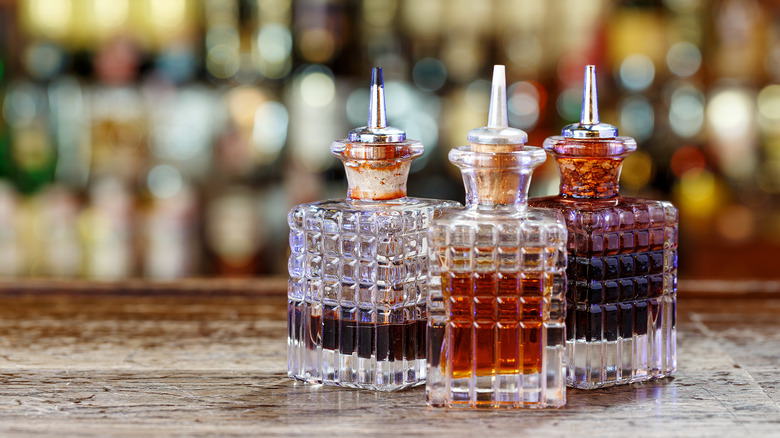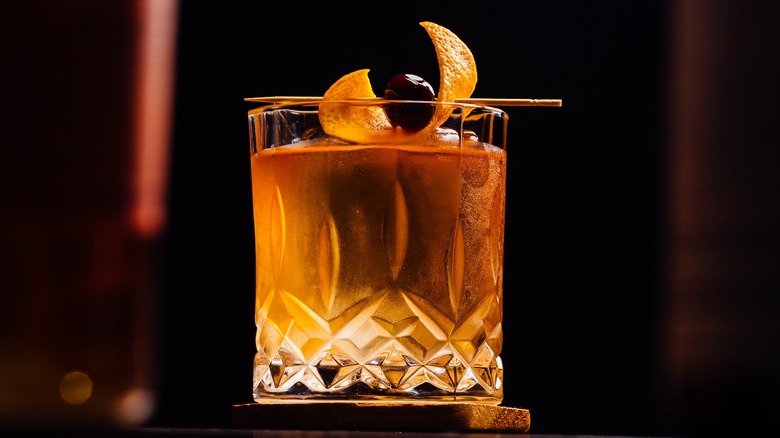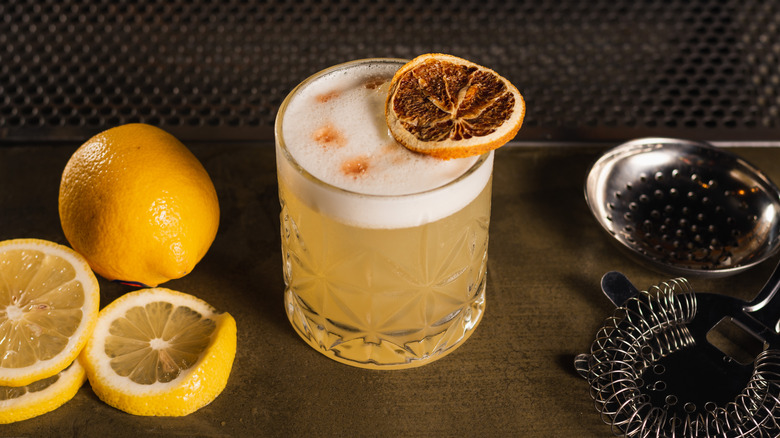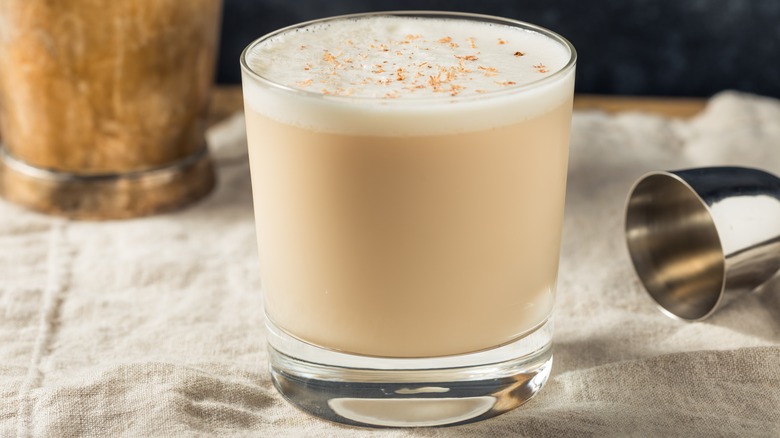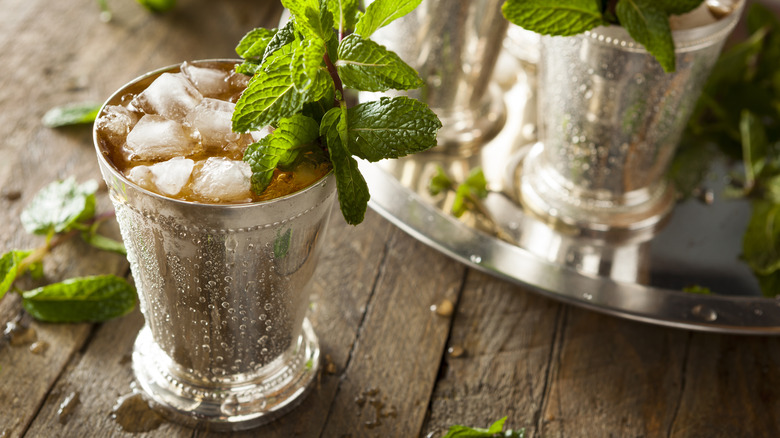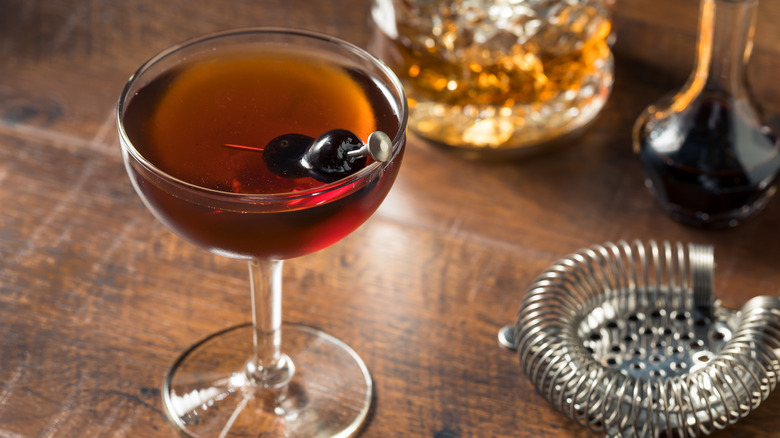5 Bitters That Transform Whiskey Cocktails
If you've ever had a flavorful whiskey cocktail that you just can't get enough of, you probably have bitters to thank for it. They are essentially concentrated flavor extracts that are used to add some complexity to cocktails – although they can easily be incorporated into non-alcoholic drinks as well. While whiskey on its own has a dry, oftentimes smoky flavor, bitters essentially act as infusions that can add hints of citrus, berries, or even spices to your drink.
There's really no reason why bitters shouldn't be a part of your mixology, especially because popular cocktails like an old fashioned and sazerac require it in their recipes. Regardless of what you want to make, choosing the right bitter to pair with a mixed drink will make the difference between a delectable whiskey beverage and a confusing mess. The following five bitters will elevate a variety of whiskey cocktails in different ways, and hopefully lead you to a more successful home bartending experience.
Transform old fashioneds with aromatic bitters, Angostura
These are some of the oldest bitters found in history. As far back as 1824, people — such as the German physician Johann Sieberg — began to create the now-iconic Angostura brand of bitters to treat soldiers in Latin America. This concoction survived through America's prohibition period, which saw the temperance movement outlaw alcoholic drinks in the country for a brief period of time. Since then, aromatic bitters have remained a mainstay in modern bartending.
Regardless of which way you're making the classic old fashioned, aromatic bitters are typically what pair best with this popular cocktail. Their flavor, which can be best described as a concoction of herbs and spices, is what gives an old fashioned its signature taste. Aromatic bitters are potent, so only a few drops are needed to make this cocktail shine. Simply swap out the licorice syrup or the fig bitters for Angostura for a delicious twist.
Brighten up whiskey sours with orange bitters
While they are almost as old as their aromatic counterparts, orange bitters didn't really get popular until the 21st century. Make no mistake in discounting these concoctions as merely citrusy, however, as they also carry a wide variety of undertones that come from spices like cardamom, cloves, cinnamon, and ginger. But orange peel ultimately remains the strongest flavor in these bitters, hence the name.
You can easily use this fruity mixer on any whiskey drink, but orange bitters shine best alongside the zesty flavors of a whiskey sour. No matter which way you choose to shake up the whiskey sour, the orange flavor of these bitters easily compliments the sourness of the lemon juice — just swap out Peychaud's bitters for orange. You can even drizzle a bit of orange bitters over the foamy egg white topping to give more visual flair to this cocktail.
Give Southern milk punch a kick with chocolate bitters
Way too few people are aware of the culinary delight that spiked milkshakes are. In Southern states like Louisiana, foodies have utilized frozen milk punch as a brunch staple for decades. Whether you're drinking it in the morning or during happy hour, the combination of bourbon, milk, cream, and vanilla served over ice remains popular for a reason. And what better way to accentuate it than by adding a splash of cocoa flavor? Enter chocolate bitters.
Much like their counterparts, chocolate bitters don't just add hints of cacao to your cocktail. Varying from brand to brand, these bitters employ hints of caramel, pepper, and even wormwood in any mixed drinks. Chocolate bitters are best alongside the bourbon milk punch for their ability to turn it into a spiced chocolate milkshake, but they shine equally as well in sours and Manhattans as well. Just add a few drops to each glass as it's served for a spicy, cocoa punch.
Refresh mint juleps with cucumber bitters
Few mixed drinks taste as refreshing as a mint julep. The clever mixture of liquor, mint, crushed iced, and a dash of sugar should suffice as to why you should be drinking mint juleps all year. The recipe for this cocktail has remained fuss-free for decades, but many people have put their own twist on this drink with even more refreshing mixers such as pineapple or lime juice.
Cucumbers, arguably the most hydrating vegetable out there, should be no exception to the mint julep recipe, and bitters remain the way to incorporate this ingredient into this cocktail. Just a splash of this concoction could not only bring the classic pairing of cucumber and mint to your beverage but also add the flavor of herbs such as rosemary or thyme. Don't skip on the Peychaud's or Angostura bitters — instead, just include a few dashes of cucumber bitters as well. Add in a cucumber slice for extra garnish, and you're certain to wow anyone with this drink.
Fortify the Manhattan with a dash of cherry bitters
For over a century, drinkers have loved the Manhattan cocktail's irresistible combination of whiskey, vermouth, and bitters. Topped with a twirl of orange peel and garnished with a cherry (or two), this classic drink easily shines without any changes to its recipe. But if you do want to spice up this mixed drink, swap the regular aromatic bitters for cherry ones. Yes, we're talking cherry-on-cherry action here for an enhanced drinking experience.
While this concoction may pair well with dark spirits such as scotch or brandy, Manhattan particularly benefits from cherry bitters due to the way they complement its existing flavor. Using cherry bitters will not only still give this cocktail its much-needed bite of bitterness, but it also provides a touch of tartness that few bartenders can replicate. These are also a great pairing for an old fashioned, swapping out aromatic bitters for a tart cherry taste.

